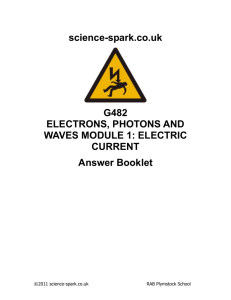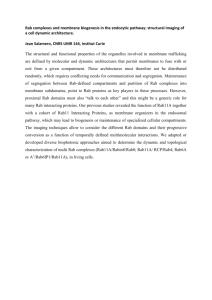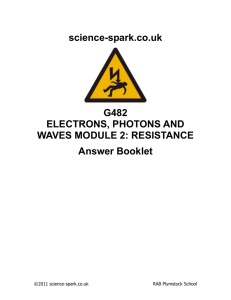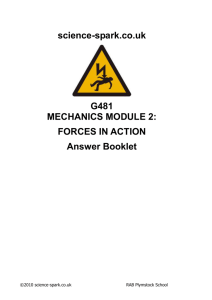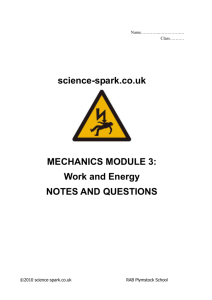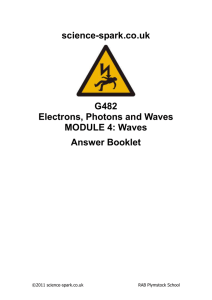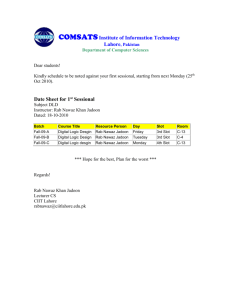Here - science
advertisement
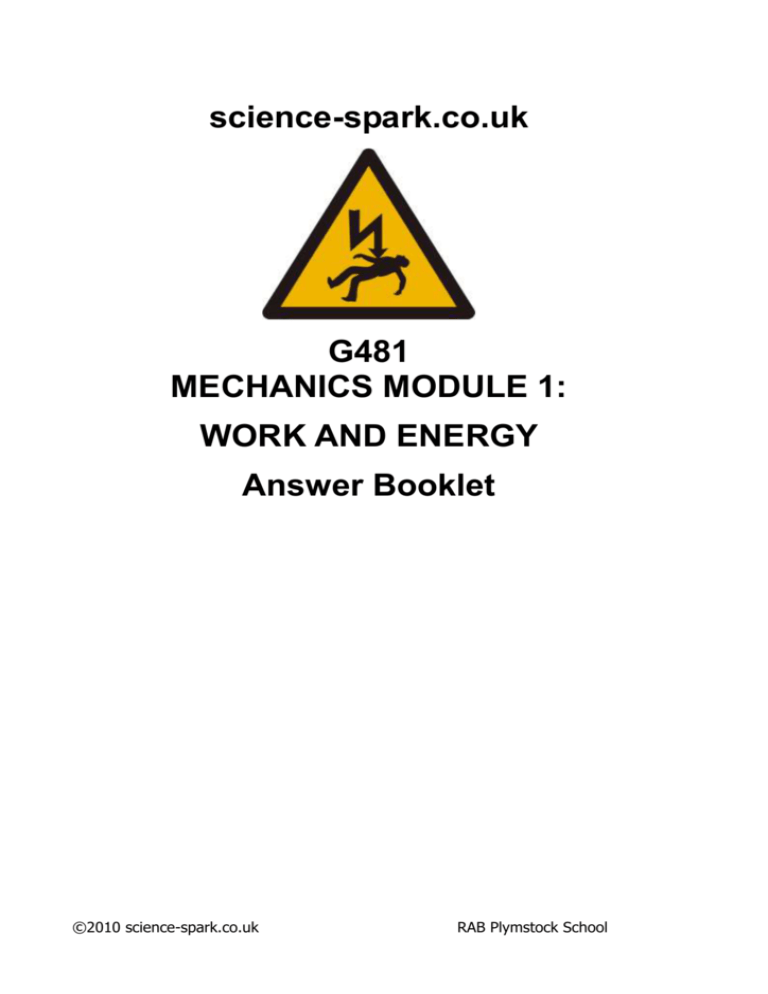
science-spark.co.uk G481 MECHANICS MODULE 1: WORK AND ENERGY Answer Booklet ©2010 science-spark.co.uk RAB Plymstock School Lesson 16 questions – Work Done 1.a) Travelling slowly, at about 5 miles an hour, the retarding forces acting on a cyclist are about 5 N. i) What propulsive force must the cyclist provide to travel at constant speed? Net force must be zero, so 5 N Force = …5…………N (1) ii) How much energy does the cyclist have to provide to cover 5 m? Work force distance 5m 5N 25 J Energy = ……25……… J (2) b) At a higher speed, nearly 10 mph the retarding forces are much larger, nearly 8 N. i) Write down the propulsive force required at this speed. Net force must be zero, so 8 N Force = …8…………N (1) ii) Calculate the energy the cyclist must provide to cover 5 m at this constant speed. Work force distance 5m 8N 40 J Energy = ……40……… J (2) c) Climbing a hill at a steady speed of 5 mph the cyclist finds herself perspiring rather more than on the flat. The mass of the cycle plus cyclist is 80 kg. The ergometer pedals fitted report the energy supplied to the bicycle as 185 J to cover a 5 m stretch of road. i) How much energy is used to lift the cyclist uphill? energy to lift energy supplied energy dissipated 185 J 25 J 160 J Energy = ……160……………J (2) ii) How much height does she gain in travelling along the 5 m stretch of road? Energy transferred m g h h 160 J 80 N 10 N kg 1 0 .2 m Height = ……0.2……..m (3) ©2010 science-spark.co.uk RAB Plymstock School iii) How much energy would she have to provide to cover this same stretch of road at 10 mph? energy supplied energy to lift energy dissipated 160 J 40 J 200 J Energy = ……200……………. J (2) iv). What is the retarding force acting on her, when travelling uphill at 10 mph? Energy transferre d force distance force 200 J 5m 40 N Force = …40…………….. N (2) v) Draw a vector diagram for the retarding forces (due to drag and gravity) acting on her at 10 mph. drag retarding force due to gravity (2) d)i) Calculate the retarding force due to the slope as a fraction of her weight. ratio 32 N 4% 800 N ……4……% (2) ii) Comment on the advantages of using the slope of the hill rather than lifting bike and rider vertically by the same distance. ………The retarding force as a percentage of weight was 4% whereas it would be 100% to go vertically up. The power needed to travel the same distance vertically would be 25 times as much because of this. …………………………………………………… (2) Total [20] ©2010 science-spark.co.uk RAB Plymstock School Lesson 27 questions – Energy calculations Note: g = 9.8 N kg-1 = 9.8 m s-2 1 A jumper of mass 75 kg jumps a height of 1.9 m (a) Calculate the gravitational potential energy of the jumper at his highest point. Gravitational potential energy = mgh = 75 x 9.8 x 1.9 = =1303.4 J = 1400 J to 2sf gravitational potential energy = ……1400………… (J) (2) (b) Calculate the vertical velocity of the jumper just before impact with the crash mat. v2 = u2 + 2as u = 0 so v 2gh. v = (2x 9.8 x 1.9)0.5 so v = 6.1 m s-1 (or from pe=ke) vertical velocity just before impact = ………6.1…………… (ms-1) (3) (c) Show that the kinetic energy associated with his vertical velocity is equal to the gravitational potential energy at the top of his jump. (ecf from b) ½ m v2 = 0.5 x 75 x 6.12 = 1395 ≈ 1400 J QED (2) (d) The jumper is stopped over a distance of 0.3 m when he lands on the crash mat. Calculate the average force on the jumper as he comes to rest. W=Fs F=W/s = 1400/0.3 Average force = ……4700………… (N) (2) Total [10] 2a) Explain the quantities i) Gravitational potential energy ……Energy transferred when moving an object of mass m a height h against a gravitational field strength g. or mgh where m – mass, g – gravitational field strength, h – height. …………………………………………………………………………………………………… …………………………………………………………………………… (2) ii) kinetic energy ………energy due to movement depending on mass and speed. or …½ m v2 where m – mass and v velocity/speed……………………………………………………………………… (2) b) Water leaves a reservoir and falls through a vertical height of 130m and causes a water wheel to rotate. The rotating wheel is then used to produce 110 kJ per second of electrical energy. ©2010 science-spark.co.uk RAB Plymstock School i) Calculate the velocity of the water as it reaches the wheel, assuming that all the gravitational potential energy is converted to kinetic energy. pe=ke mgh=½ m v2 9.8 x 130 = 0.5 v2 v = (2x9.8x130) velocity = ……50 (2sf)…………… ms-1 (3) ii) Calculate the mass of water flowing through the wheel per second, assuming the production of electrical energy is 100% efficient. electrical energy = 110 000 Js-1 110 = ½ m v2 m = (2x110000)/502 (or mgh) mass of water per second = ……88………….. unit…kg…… (3) iii) State and explain two reasons why the mass of water flowing per second needs to be greater than the value in (ii) in order to produce the amount of electrical energy stated. ………not all pe converted to ke through friction of water with ground or air resistance. ………not all ke transferred, the water retains some ke. ………friction in rotation of wheel so not all ke converted to electrical ………friction in generator not all ke converted to electrical ……………………………………………………………… …………………………………………………………………………………………………… …………………………………………………………………………………………………… ……………………………………………………………………………… (2) Total [12] ©2010 science-spark.co.uk RAB Plymstock School Lesson 31 questions – Hooke’s Law 1 Fig 1.1 shows a spring that is fixed at one end and is hanging vertically. ai) Calculate the spring constant of the spring. F/x=k 2.0N/0.25m b) spring constant = ……8……….. unit ……N/m…. (3) The mass M is pulled down a further 150mm by a force F additional to its weight. i) Determine the force F. extension of line F = ……3.2………… N (1) ii) State any assumptions made. …………elastic limit / ultimate tensile stress not reached………………………………………………………………………………… (1) ©2010 science-spark.co.uk RAB Plymstock School Lesson 32 questions - Strain Energy 1)a) State Hooke’s Law: ……Force is directly proportional to extension………………………… ………………………………………………………………………………………… (1) b) Fig 1.1 shows a graph of force F against extension e for a metal in the form of a wire. The cross sectional area of the wire is 1.80x10-7 m2 and its length is 1.70m. fig 1.1 i) Calculate the Young modulus of the metal. E=stress/strain =(FL)/(AΔL) =(29x1.70)/(1.80x10-7 x 1.6x10-3) Young modulus = …1.71x1011………… Unit……Pa (Nm-2)……. (5) ii) Calculate the energy stored in the wire when it extended by 1.60mm. W=1/2 FΔL =1/2 x 29 x 1.6x10-3 energy stored = ……0.0232…………….. J (3) Total [8] 2 a) Hooke’s Law states that F=kx. What do F, k and x represent? ……F – Force applied to material k – spring constant (stiffness) x – extension of material…………………………………………… (1) ©2010 science-spark.co.uk RAB Plymstock School b) A spring is compressed by applying a force. Fig 2.1 shows the variation of force F with compression x. Fig 2.1 i) Calculate the spring constant. F=kx F/x=k grad = k =125/50x10-3 spring constant = ……25000……….. unit ……Nm-1………. (2) ii) Show that the work done in compressing the spring by 48mm is 2.9 J. W=1/2 Fx =1/2 x 120 x 48x10-3 =2.88≈2.9J QED (2) c) Fig 2.2 shows the spring in a toy gun. The spring is used to fire a dart of mass 15g vertically. ©2010 science-spark.co.uk RAB Plymstock School Fig 2.2 i) The spring is compressed by 48mm in the gun. When the gun is fired the strain energy in the spring is converted into kinetic energy of the dart. Calculate the speed with which the dart initially leaves the spring when the gun is fired. Assume all strain energy = kinetic energy 2.9J = ½ m v2 2.9 = 0.5 x (15x10-3)x v2 v=(2.9/(0.5 x (15x10-3))) v=19.66 speed = …………19.7………….. ms-1 (3) ii) Give two reasons why the dart is unlikely to have 2.9J of gravitational potential energy when it reaches its maximum height. 1……The dart will lose energy because of Air resistance ………………….. ……………………………………………………………………………………………… ……………………………………………………………………………………………… 2………friction in the gun………………………………………… ………………………………………………………………………………………… (2) Total [10] ©2010 science-spark.co.uk RAB Plymstock School Lesson 33 questions - Young modulus 1 a) A strip of rubber originally 75 mm long is stretched until it is 100 mm long. What is the tensile strain? strain extension original length 25 mm 75 mm This is sometimes expressed as a strain of 33%. Strain = …… 0.33…….. (2) b) Why has the answer no units? ...........It is a ratio of two lengths............................................................................. .....................................................................................................................................(1) 2. The greatest tensile stress which steel of a particular sort can withstand without breaking is about 109 N m-2. A wire of cross-sectional area 0.01 mm2 is made of this steel. What is the greatest force that it can withstand? stress force area so F = stress x A = 109 N m–2 –8 m2 Force = ……10……. N (2) 3. Find the minimum diameter of an alloy cable, tensile strength 75 MPa, needed to support a load of 15 kN. stress force area so force stress 15 kN area 75 MN m – 2 Area = 2 x 10–4 m2 A d 2 4 so d d 2 4 d 4 2 10 4 m 2 3.14 diameter = …1.6 x 10–2…………unit…m…. (3) ©2010 science-spark.co.uk RAB Plymstock School 4. Calculate the tensile stress in a suspension bridge supporting cable, of diameter of 50 mm, which pulls up on the roadway with a force of 4 kN. A d 2 4 3.14 (50 10 3 m)2 4 =1.96 x 10–3 m2 force area 4 kN stress 1.96 10 -3 m2 Stress = ……2.0 …………. MPa (3) 5. Calculate the tensile stress in a nylon fishing line of diameter 0.36 mm which a fish is pulling with a force of 20 N A d 2 4 3.14 (0.36 10 3 m)2 4 = 1.017 x 10-7 m2 stress force area 20 N 1.017 10 – 7 m 2 Stress = 200 MPa (3) 6. A large crane has a steel lifting cable of diameter 36 mm. The steel used has a Young modulus of 200 GPa. When the crane is used to lift 20 kN, the unstretched cable length is 25.0 m. Calculate the extension of the cable. A d 2 4 3.14 (3.6 10 2 m) 2 4 –3 =1.02 x 10 m2 E F A l l so l F l A E 20 10 3 N 25 m 1.02 10 – 3 m 2 2 1011 N m – 2 Δl = 2.5 x 10–3 m extension = …2.5 …………. unit … mm ……. (4) ©2010 science-spark.co.uk RAB Plymstock School 7 a) Define: (i) stress ..........Force per unit cross section area..................................................................... .....................................................................................................................................(1) (ii) strain .........extension per unit original length...................................................................... .....................................................................................................................................(1) b) (i) Distinguish between elastic and plastic behaviour when materials are stretched. .......Elastic returns to original length/size................................................................. ........Plastic does not return to original length/size..................................................... ..........when load is released....................................................................................... ....................................................................................................................... (2) (ii) Define elastic limit .........Force (or extension) beyond which a material will not return to original length...................................................................................................................... .....................................................................................................................................(1) c) (i) State the SI unit of the Youngs modulus. unit =........Pascal (Nm-2)..............................(1) ©2010 science-spark.co.uk RAB Plymstock School (ii) Describe, with the aid of a diagram, an experiment to determine the Youngs modulus of steel in the form of a wire. Explain how to use your readings to obtain the Youngs modulus. X Y .......... A load is attached to wire X to keep it taut. A load is attached to wire Y sufficient to remove any kinks. (this is not counted as part of the final load) The original length of Y is measured (1) from the support to the vernier scale with a measuring tape or ruler. The diameter is measured with a micrometer, (1) (measured at different points and averaged). From these, the mean radius is taken. The initial vernier reading is noted with no load on Y. A load is then added and the new vernier reading taken. This procedure is repeated adding loads in 10 Newton steps up to a maximum of 60N. Loads are then removed and the vernier reading recorded again. (1) The extension for each load is calculated by subtracting the original vernier reading from the mean reading. A graph is then plotted of load F(N) against extension ΔL(m). (1) The gradient = F/ΔL, So E = gradient x L/πr2 (1) The second wire makes sure that any temperature affects are eliminated. (1) A long wire is used to increase the extension and reduce fractional uncertainty. (reduce any errors made in measuring length and extension) (1) (7) ©2010 science-spark.co.uk RAB Plymstock School Lesson 34 questions – material properties 1) Here is the graphical output from tensile testing of five materials: Perspex, polypropylene, aluminium, brass and mild steel. Load is on the Y axis and extension is on the X axis. The extension is not to same scale as they vary a lot. Perspex Polypropylene 4000 4000 3000 3000 2000 2000 1000 1000 0 0 extension extension Aluminium Brass 2000 8000 1500 6000 1000 4000 500 2000 0 0 extension extension Mild steel 5000 4000 2000 1000 0 a) State which material has the highest yield load and take a measurement of this value ……………… mild steel 4600 N (+/- 200N).……………………………………………… (2) b) Which sample has the lowest maximum ultimate stress? ………………Aluminium………………………………………………………………………. ……………………………………………………………………………………………… (1) Total [3] ©2010 science-spark.co.uk RAB Plymstock School 2 Three materials P, Q and R have force-extension graphs as shown in Fig 2.1. Fig 2.1 State and explain which of these three materials you would choose for the following applications. i) making foundations of a building ……P……………………………………………………………………………………………. ……Has small extension for large compression forces and will return to initial shape…………………. ……………………………………………………………………………………………… (2) ii) forming into a wire ……Q…………………………………………………………………………………………. ……under tension or compression it will return to initial shape but if enough force given it will change shape and stay at this shape ………………………………………. ……………………………………………………………………………………………………. ……………………………………………………………………………………………… (2) iii) making an elastic rope (e.g. a bungee-jump rope) ……R……………………………………………………………………………………………. ……Will extend with small forces and seems to have polymeric shape, does not seem to have reached elastic limit with forces shown meaning it will be able to go back to original shape………………………………………………………………………………………… (2) iv) making a beam to support a roof …… P……………………………………………………………………………………………. ……Has small extension for large compression forces and will return to initial shape … (2) ©2010 science-spark.co.uk RAB Plymstock School
